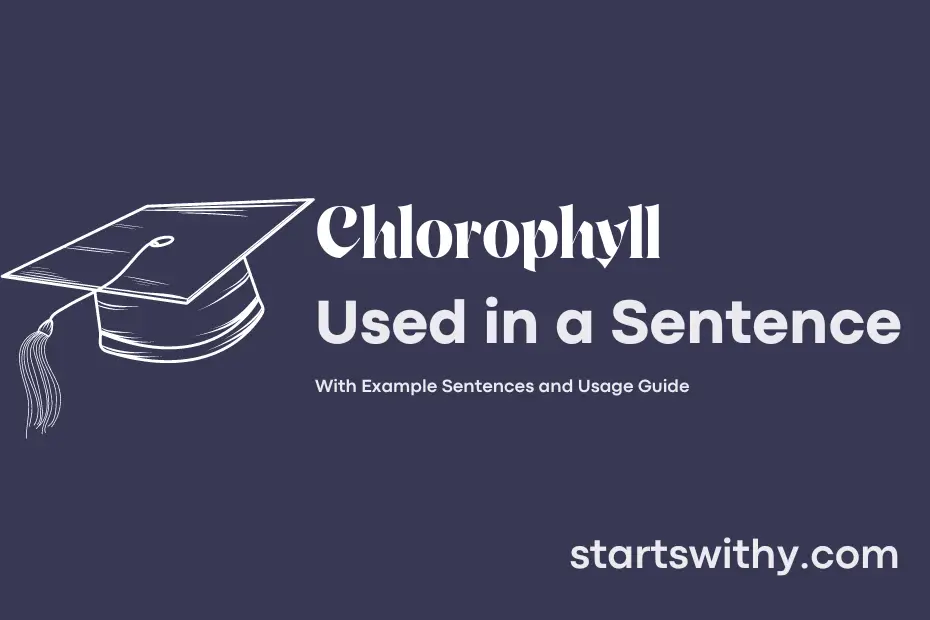Have you ever wondered what gives plants their vibrant green color and allows them to undergo photosynthesis? The answer lies in a crucial pigment known as chlorophyll.
Chlorophyll is a green pigment found in the chloroplasts of plant cells and is responsible for absorbing light energy from the sun. This energy is then used to convert carbon dioxide and water into glucose, a process essential for the plant’s survival.
7 Examples Of Chlorophyll Used In a Sentence For Kids
- Chlorophyll makes plants green.
- Sunlight helps chlorophyll make food for plants.
- Leaves have chlorophyll inside them.
- Plants use chlorophyll to grow big and strong.
- We need plants with chlorophyll for fresh air.
- Green vegetables have a lot of chlorophyll.
- Without chlorophyll, plants cannot make food.
14 Sentences with Chlorophyll Examples
- Chlorophyll is the green pigment found in plants that is crucial for photosynthesis.
- During biology class, we learned about the role of chlorophyll in capturing sunlight and converting it into chemical energy.
- Many college students use chlorophyll supplements to boost their energy levels and improve their focus.
- The laboratory experiment involved extracting chlorophyll from spinach leaves to observe its fluorescence under a microscope.
- As part of our environmental science project, we studied the impact of pollution on the production of chlorophyll in plants.
- Incorporating chlorophyll-rich foods like leafy greens and spirulina into your diet can help enhance your overall health.
- Our botany professor challenged us to create a presentation on the benefits of chlorophyll for sustainable agriculture practices.
- The internship opportunity at the botanical garden allowed me to work closely with researchers studying the effects of climate change on chlorophyll production.
- A seminar on the importance of chlorophyll in maintaining a healthy ecosystem inspired many students to pursue careers in environmental science.
- After conducting experiments on the effects of different light wavelengths on chlorophyll synthesis, we were able to draw important conclusions.
- The biology textbook we are using for our course provides detailed explanations on the structure and function of chlorophyll molecules.
- To deepen our understanding of photosynthesis, we visited a greenhouse to observe how plants utilize chlorophyll to convert sunlight into energy.
- The research paper on the potential applications of chlorophyll in medicine sparked a lively debate among our classmates.
- Students interested in pursuing a career in plant biology are often fascinated by the intricate processes involving chlorophyll within plant cells.
How To Use Chlorophyll in Sentences?
Chlorophyll is a green pigment found in plants that plays a crucial role in photosynthesis. When using the word chlorophyll in a sentence, it is important to remember its significance in the plant kingdom.
Here’s an example of how to use chlorophyll in a sentence: “The vibrant green color of plants is due to the presence of chlorophyll, which captures sunlight to produce energy for the plant.”
When incorporating chlorophyll into a sentence, try to provide context about its function or properties. For instance, “Spinach is a good dietary source of chlorophyll, which is believed to have various health benefits.”
Remember to spell chlorophyll correctly and use it in the appropriate context. Avoid overusing the word in a sentence, as it can make the sentence less clear. Instead, aim to use chlorophyll in a concise and meaningful way to enhance your writing.
In summary, chlorophyll is a key component in plants that facilitates photosynthesis. By understanding its role and importance, you can effectively incorporate this word into your writing to convey information about plant biology and nutrition.
Conclusion
In conclusion, chlorophyll is an essential pigment found in plants that plays a critical role in photosynthesis, the process by which plants convert sunlight into energy. This green pigment captures light energy and uses it to produce glucose, which is the plant’s source of food and energy. Without chlorophyll, plants would not be able to photosynthesize and sustain themselves.
From examples like “Chlorophyll gives plants their green color” to “Photosynthesis relies on chlorophyll to convert sunlight into energy,” it is evident that chlorophyll is indispensable for the survival and growth of plants. Understanding the importance of chlorophyll in plant biology sheds light on the fundamental processes that support life on Earth and highlights the interconnectedness of all living organisms.



